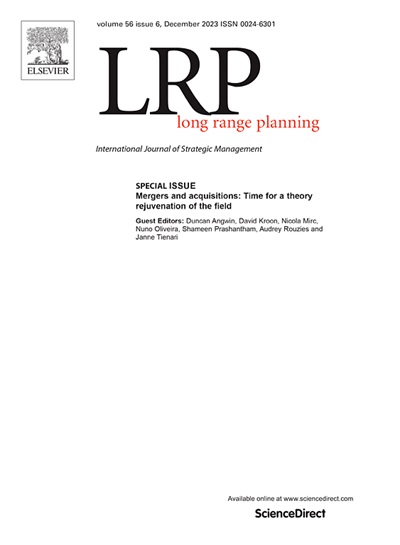Towards a deeper understanding of performance variance in the context of business groups: A multilevel analysis at the business unit level
IF 6.3
2区 管理学
Q1 BUSINESS
引用次数: 0
Abstract
In this study, we employ a multilevel analysis to investigate the relative importance of industry, business group, corporation, and business unit effects on the performance of business units that are nested within business group affiliates. Empirical results demonstrate that business unit effects explain (1) about four times as much variance as does the corporate effects, (2) over four times as much variance as the industry effects, and (3) over eighteen times as much variance as the business group effects in business unit performance. Moreover, the results provide evidence that corporate effects are distinct from business group effects and it is imperative to study the complex interplay between the two distinct headquarters to understand the impact of business group as an organizational form. These findings extend our theoretical and empirical understanding of performance variability in the context of business groups.
更深入地理解业务组上下文中的性能差异:业务单元级别的多层次分析
在本研究中,我们采用多层次分析来调查行业、业务集团、公司和业务单位对嵌套在业务集团附属公司中的业务单位绩效的相对重要性。实证结果表明,业务单元效应对业务单元绩效的解释(1)是公司效应的四倍左右,(2)是行业效应的四倍以上,(3)是业务集团效应的18倍以上。此外,研究结果还表明,企业效应与企业集团效应是不同的,为了理解企业集团作为一种组织形式的影响,有必要研究这两种不同总部之间复杂的相互作用。这些发现扩展了我们在商业集团背景下对绩效可变性的理论和实证理解。
本文章由计算机程序翻译,如有差异,请以英文原文为准。
求助全文
约1分钟内获得全文
求助全文
来源期刊

Long Range Planning
Multiple-
CiteScore
13.00
自引率
7.10%
发文量
75
期刊介绍:
Long Range Planning (LRP) is an internationally renowned journal specializing in the field of strategic management. Since its establishment in 1968, the journal has consistently published original research, garnering a strong reputation among academics. LRP actively encourages the submission of articles that involve empirical research and theoretical perspectives, including studies that provide critical assessments and analysis of the current state of knowledge in crucial strategic areas. The primary user base of LRP primarily comprises individuals from academic backgrounds, with the journal playing a dual role within this community. Firstly, it serves as a platform for the dissemination of research findings among academic researchers. Secondly, it serves as a channel for the transmission of ideas that can be effectively utilized in educational settings. The articles published in LRP cater to a diverse audience, including practicing managers and students in professional programs. While some articles may focus on practical applications, others may primarily target academic researchers. LRP adopts an inclusive approach to empirical research, accepting studies that draw on various methodologies such as primary survey data, archival data, case studies, and recognized approaches to data collection.
 求助内容:
求助内容: 应助结果提醒方式:
应助结果提醒方式:


